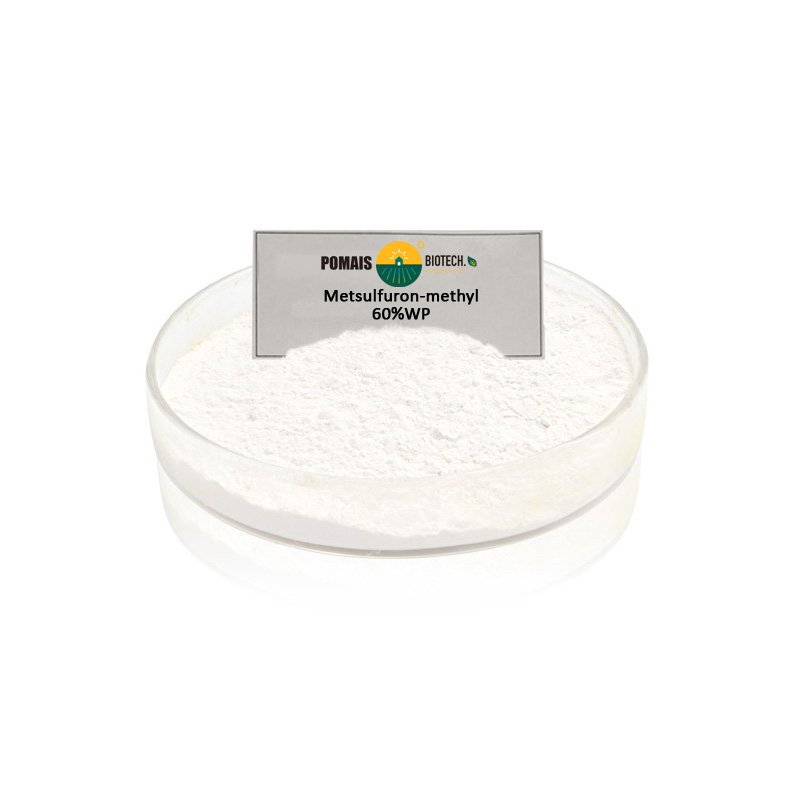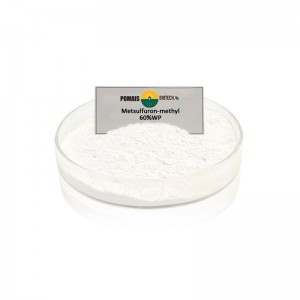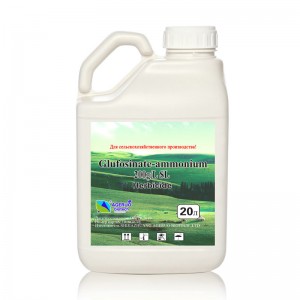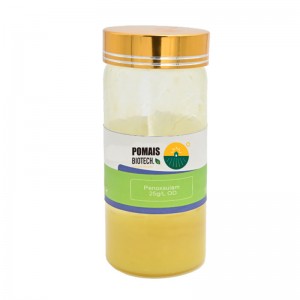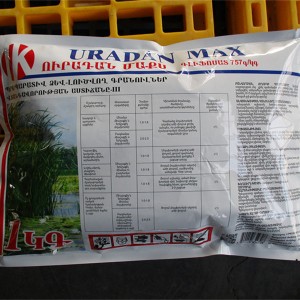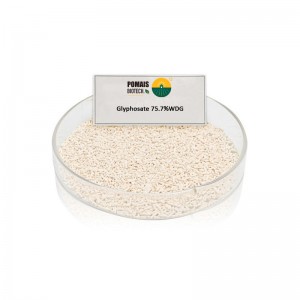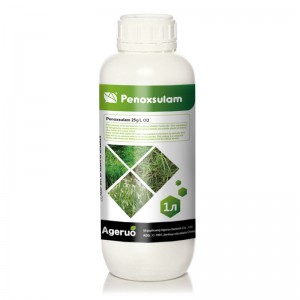Products
POMAIS Herbicide Metsulfuron-methyl 60%WP,40%WDG,60%WDG
Metsulfuron-methyl Herbicide Mode of Action
Metsulfuron-methyl disrupts the normal growth process of weeds by inhibiting the ALS, resulting in the accumulation of toxic levels of certain amino acids in the plant. This disruption leads to the cessation of growth and eventual death of the weed, making it an effective solution for weed management.
Related reading: Mode of Action of Metsulfuron Methyl
Uses of Metsulfuron-methyl
Metsulfuron-methyl is primarily used to control broadleaf weeds and some grasses in a variety of crops including cereals, pastures and non-crop areas. Its selectivity allows it to target specific weeds without damaging the desired crop, making it the preferred choice for integrated weed management strategies.
Related reading: 2, 4-D metsulfuron methyl or glyphosate: What’s the difference?
| SITUATION | WEEDS CONTROLLED | RATE* | CRITICAL COMMENTS | ||
| HANDGUN (g/100L) | GROUND BOOM(g/ha) | GAS GUN (g/L) | FOR ALL WEEDS: Apply when target weed is in active growth and not under stress from waterlogging, drought etc |
||
| Native Pastures, Rights of Way, Commercial and Industrial Areas | Blackberry (Rubus spp.) | 10 + Mineral Crop Oil(1L/100L) | 1 + anorganosilicon e penetrant (10mL/ 5L) | Spray to thoroughly wet all foliage and canes. Ensure peripheral runners are sprayed.Tas: Apply after petal fall. Do not apply to bushes bearing mature fruit. Vic: Apply between December and April |
|
| Bitou Bush/ Boneseed (Chrysanthemoidesmonilifera) | 10 | Minimise contact with desirable plants. Apply to point of run-off. | |||
| Bridal Creeper (Myrsiphyllum asparagoides) | 5 | Apply from mid-June to late August. To achieve complete control follow-up applications over at least 2 seasons are required. To minimise damage to native vegetation, water volumes of 500-800L/ha are recommended. | |||
| Common Bracken(Pteridium esculentum) | 10 | 60 | Apply after 75% of fronds are fully expanded. Spray tothoroughly wet all foliage but not to cause run-off. For boom application adjust boom height to ensure complete spray overlap. | ||
| Crofton Weed (Eupatorium adenophorum) | 15 | Spray to thoroughly wet all foliage but not to cause run- off. When bushes are in thickets ensure good spraypenetration. Apply up to early flowering. Best results are obtained on younger plants. Should regrowth occur, re- treat in the next growth period. | |||
| Darling Pea (Swainsona spp.) | 10 | Spray during spring. | |||
| Fennel (Foeniculum vulgare) | 10 | ||||
| Golden Dodder (Cuscuta australis) | 1 | Apply as a spot spray to point of run-off at pre- flowering. Ensure correct coverage of infested area. | |||
| Great Mullein (Verbascum thapsus) | 20 + anorganosili cone penetrant (200mL /100L) |
Apply to rosettes during stem elongation during springwhen soil moisture is good. Regrowth may occur if plants are treated when growing conditions are not good. | |||
| Harrisia Cactus (Eriocereus spp.) | 20 | Spray to thoroughly wet using water volumes of 1,000 -- 1,500 litres per hectare. A follow-up treatment may benecessary. | |||
Combined Use of Dicamba and Metsulfuron Methyl
The combination of Dicamba and Metsulfuron Methyl can improve the effectiveness of weed control, especially when dealing with resistant weeds.Dicamba kills weeds by affecting phytohormone balance, while Metsulfuron Methyl prevents weed growth by inhibiting amino acid synthesis, and the combination of these two products can be used to eliminate weeds more effectively.
Combination of Clodinafop Propargyl and Metsulfuron Methyl
The combination of Clodinafop Propargyl and Metsulfuron Methyl is commonly used to control a wide range of weeds, especially in lawns and crops that are resistant to a single herbicide. weeds, while Metsulfuron Methyl is more effective on broadleaf weeds, and the combination of the two provides a broader range of weed control.
Related reading: Mixing Dicamba or 2,4-D with Metsulfuron Methyl
Spray Preparation
The product is a dry flowable granule which must be mixed with clean water.
1. Partially fill the spray tank with water.
2. With the agitation system engaged, add the required amount of product (as per Directions for Use Table) to the tank using only the measuring device provided.
3. Add the remainder of the water.
4. Always maintain agitation to keep the product in suspension. If the spray solution is allowed to stand, thoroughly re- agitate before using.
If tank mixing with another product, ensure Smart Metsulfuron 600WG is in suspension before adding the other product to the tank.
If using in conjunction with liquid fertilisers, slurry the product in water before mixing the slurry into the liquid fertiliser. Do not add surfactants and check with the Department of Agriculture on compatibility.
Restraints
Do not spray if rainfall is expected within 4 hours.
Do not store the prepared spray for more than 2 days.
Do not store tank mixes with other products.
Do not apply to pastures based on paspalum notatum or setaria spp. As their vegetative growth will be reduced.
Do not treat newly sown pastures as severe damage may occur.
Do not use on pasture seed crops.
Crop Rotation Recommendations
Many crop species are sensitive to metsulfuron methyl. The product is broken down in the soil mainly by chemical hydrolysis and to a lesser degree by soil microbes. Other factors which affect breakdown are soil pH, soil moisture and temperature. Breakdown is faster in warm, wet acid soils and slowest in alkaline, cold, dry soils.
Legumes will be removed from pasture if they are over sprayed with the product.
Other species which are sensitive to metsulfuron methyl are:
Barley, Canola, Cereal Rye, Chickpeas, Faba Beans, Japanese Millet, Linseed, Lupins, Lucerne, Maize, Medics, Oats, Panorama Millet, Peas, Safflower, Sorghum, Soybeans, Sub Clover, Sunflower, Triticale, Wheat, White French Millet.
Application Equipment
For control of weeds in winter cereal crops the product may be applied by ground or air.
Ground Spraying
Ensure the boom is properly calibrated to a constant speed or rate of delivery for thorough coverage and uniform spray pattern. Avoid overlapping and shut off boom while starting, turning, slowing or stopping as injury to the crop may occur. Apply in a minimum of 50L prepared spray/ha.
Aerial Application
Apply in a minimum of 20L/ha. Application in higher water volumes may improve weed control reliability. Avoid spraying in conditions which favour temperature inversions, still conditions, or in winds likely to cause drift onto sensitive crops or fallow areas to be planted to sensitive crops. Turn off boom when passing over creeks, dams or waterways.
The use Micronair equipment is not recommended as the fine droplets emitted may lead to spray drift.
Comparison
Metsulfuron-methyl vs. 2,4-D and Glyphosate
When comparing Metsulfuron-methyl with other herbicides such as 2,4-D and Glyphosate, it is important to consider mode of action, selectivity and environmental impact. Metsulfuron is more selective than glyphosate and therefore less likely to damage non-target plants. However, it is not as broad-spectrum as glyphosate, which controls a wider range of weeds. In contrast, 2,4-D is also selective but has a different mode of action, mimicking plant hormones and causing uncontrolled growth of susceptible weeds.
Chlorsulfuron vs Metsulfuron Methyl
Chlorsulfuron and Metsulfuron Methyl are both sulfonylurea herbicides, but they differ in their scope of application and selectivity; Chlorsulfuron is commonly used to control some persistent weeds, especially in crops such as wheat. In contrast, Metsulfuron Methyl is better suited for controlling broadleaf weeds and is also widely used in turf management and non-crop areas. Both are unique in their application methods and effectiveness, and the choice should be based on the specific weed species and crop.
FAQ
What Does Metsulfuron-methyl Kill?
Metsulfuron-methyl is effective against a wide range of broadleaf weeds, including thistle, clover and many other noxious species. It can also control some grasses, although its main strength is its effectiveness on broadleaf species.
Does Metsulfuron-methyl Kill Grass?
Although Metsulfuron-methyl is primarily used to control broadleaf weeds, it also affects certain grasses. However, its effects on grasses are usually less pronounced, making it suitable for use in areas dominated by grasses requiring broadleaf weed control.
Can Metsulfuron Methyl be used on Bermuda lawns?
Metsulfuron Methyl can be used on Bermuda lawns, but its dosage needs to be carefully controlled. Because Metsulfuron Methyl is a selective herbicide that primarily targets broadleaf weeds, it is less harmful to bermudagrass when used at appropriate concentrations. However, high concentrations may adversely affect turf, so small-scale testing is recommended prior to application.
Bridal Creeper Control with Metsulfuron-methyl
Bridal Creeper is a highly invasive plant that can be effectively controlled with Metsulfuron-methyl. This herbicide has proven to be particularly effective in controlling Bridal Creeper infestations in Chinese agricultural practices, reducing the spread of this invasive species.
How to Apply Metsulfuron Methyl
When applying Metsulfuron Methyl, the target weed species and growth stage should be determined first. Metsulfuron Methyl is usually most effective when the weeds are at an active growth stage.Metsulfuron Methyl is usually mixed with water and sprayed uniformly over the target area by means of a sprayer. Use in strong wind conditions should be avoided to prevent drift to non-target plants.
How to Use Metsulfuron-methyl Herbicide
Herbicides should be applied when the target weed is actively growing, usually early after seedling emergence. Application techniques may vary depending on the crop and specific weed problem, but the key is to ensure uniform coverage of the target area.
How to Mix Metsulfuron-methyl
Mixing Metsulfuron-methyl requires care to ensure proper dilution and effectiveness. Typically, the herbicide is mixed with water and applied with a sprayer. The concentration depends on the target weed species and the type of crop being treated.

